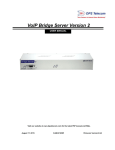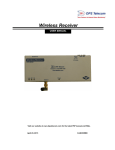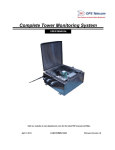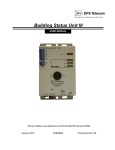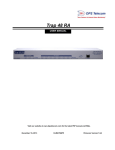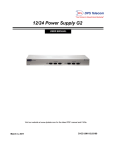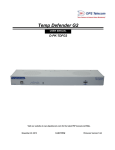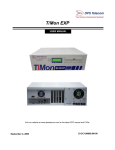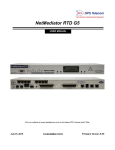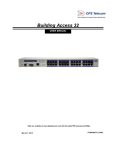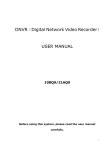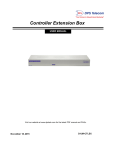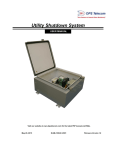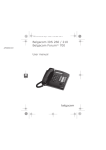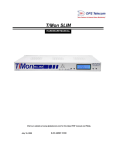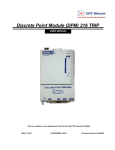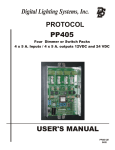Download VoIP Orderwire (Offnet)
Transcript
VoIP Orderwire with Offnet
USER MANUAL
Visit our website at www.dpstelecom.com for the latest PDF manual and FAQs.
December 21, 2010
D-OC-UM10C.21200
Firmware Version 1.0A
Revision History
December 21, 2010
Updated instructions for directory setup.
November 17, 2010
Included directions to use the OW Config utility to setup
directory listings.
July 1, 2010
Initial release.
This document contains proprietary information which is protected by copyright. All rights are reserved. No part of this
document may be photocopied without prior written consent of DPS Telecom.
All software and manuals are copyrighted by DPS Telecom. Said software and manuals may not be reproduced, copied,
transmitted or used to make a derivative work, by either mechanical, electronic or any other means in whole or in part,
without prior written consent from DPS Telecom, except as required by United States copyright laws.
© 2010 DPS Telecom
Notice
The material in this manual is for information purposes and is subject to change without notice. DPS Telecom shall not be
liable for errors contained herein or consequential damages in connection with the furnishing, performance, or use of this
manual.
Contents
Visit our website at www.dpstelecom.com for the latest PDF manual and FAQs
1 VoIP Orderwire (Offnet) Overview
1
2 Specifications
1
3 Shipping List
2
4 Installation
3
4.1 Tools Needed
3
4.2 Mounting
4
4.3 External Speaker
4
5 VoIP Orderwire Back Panel
5
5.1 Power Connection (-48 or -24VDC Build Option)
5
5.2 LAN Connection
6
5.3 Line Connection
6
6 VoIP Orderwire Front Panel
6.1 Craft Port
7 Quick Start: How to Give the Orderwire an IP Address
6
6
7
7.1 ...via Craft Port (using TTY interface)
9
7.2 ...via LAN
9
8 TTY Interface
10
8.1 Change Ethernet Settings
10
8.2 View Directory
11
8.3 View Hardware Config & Stats
11
9 Three Modes of Operation
12
9.1 Direct Station-to-Station Calling (Option #1)
12
9.2 Hoot 'n Holler (Option #2)
12
9.3 Bridge Party Line (Option #3)
13
10 Web Browser
14
10.1 Logging on to the VoIP Orderwire
14
10.2 Changing the Default Password
15
10.3 System Settings
16
10.4 Ethernet Settings
17
10.5 Offnet Calling
18
11 How to: Setup Directory Listings
18
11.1 Configuring Call Groups
19
11.2 Configuring H&H Teams
20
11.3 Configuring Conference Servers
20
12 How To: Navigate the Voice Menus
20
13 How To: Talk to Third-Party SIP Devices
21
14 How To: Upgrade Firmware
22
15 Reference: Front and Back Panel LEDs
23
16 Technical Support
24
17 End User License Agreement
25
1
1
VoIP Orderwire (Offnet) Overview
Fig. 1.1 VoIP Orderwire delivers fast, convenient communication between sites.
This next-gen orderwire product from DPS Telecom delivers voice communication at all your LAN
sites. Using VoIP (Voice over IP) technology, you call another orderwire station, a select group of
stations, or use the Hoot ‘n Holler “all call” feature to page someone when you’re not sure where they
are.
Each VoIP OrderWire unit installs easily - just plug into your LAN hub. In just 1 RU of space, you can
get rid of all those costly telephone lines and long-distance fees. VoIP communication uses the
industry-standard SIP 2.0 protocol and G.711 codec, making this orderwire system even easier to work
with if you’re already familiar with VoIP.
2
Specifications
Dimensions:
Weight:
Mounting:
Protocol:
Voice Codec:
Power Input:
Fuse:
Interfaces:
1.72" H x 17.0" W x 6.64" D
2.6 lbs
19" or 23" rack or wall mount
SIP 2.0, RTP
G.711 Mu-Law
Dual -48 VDC, +24 VDC, or -24 VDC (build options)
Dual 1/2 Amp GMT Fuses
1 RJ45 10BaseT Ethernet port
1 DB9 craft port, 9600 Baud serial
1 RJ-11 Telco jack (optional)
1 2-Wire handset jack *
1 External speaker jack *
5 or 6 Front Panel LED
5 Back Panel LEDs
Visual Interface:
Operating Temperature:
Operating Humidity:
RoHS:
Handset:
32°–140° F (0°–60° C)
0%–95% non-condensing
5/6
Standard 2-Wire telephone (optional)
External Speaker:
Yes (optional)
* These jacks can be located on the front or the back of the unit, specified when you order.
This unit does not contain any operator-serviceable parts.
All servicing is to be performed by DPS Telecom only.
2
3
Shipping List
Please make sure all of the following items are included with your VoIP Orderwire. If parts are missing,
or if you ever need to order new parts, please refer to the part numbers listed and call DPS Telecom
at 1-800-622-3314.
VoIP Orderwire
D-PK-216OW
6 ft. DB9M-DB9F Download Cable
D-PR-045-10A-04
VoIP Orderwire User Manual
D-OC-UM10C.21200
14 ft. Ethernet Cable
D-PR-923-10A-14
x2
19" Rack Ears
D-CS-325-10A-00
23" Rack Ears
D-CS-325-10A-01
x2
x2
Two Standard Rack Screws
1-000-12500-06
x4
Four 3/8" Ear Screws
1-000-60375-05
x2
Two Metric Rack Screws
2-000-80750-03
Pads
2-015-00030-00
x2
2-Pin Connector
2-820-00862-02
x3
1/2 Amp Fuses
2-741-00500-00
3
2-Wire Telephone (Optional)
D-PR-675-10A-00
External Speaker (Optional)
FDO-1200-10A-00
Small 2-Pin Connector and 6ft cable
(for plugging in External Speaker)
2-820-00812-02
4
4.1
Installation
Tools Needed
To install the VoIP Orderwire, you'll need the following tools:
Phillips No. 2 Screwdriver
PC with terminal emulator,
such as HyperTerminal
Small Standard No. 2 Screwdriver
4
4.2
Mounting
Flush mount - Rack ears are installed @ front of the unit, with front panel flush to the rack
Rack mount - Rack ears are installed @ back of the unit
Fig. 4.1 The VoIP Orderwire can be flush or rear-mounted
The Orderwire mounts in a 19" or 23" rack, and can be mounted on the right or left, in the flush-mount
or rear mount locations.
Fig. 4.2
Fig. 4.3
4.3
External Speaker
Fig. 4.4 - Connecting the external speaker.
5
5
VoIP Orderwire Back Panel
Fig. 5.1 VoIP Orderwire back panel connections.
5.1
Power Connection (-48 or -24VDC Build Option)
VoIP Orderwire is powered by two screw terminal barrier plug power connectors.
Fig. 5.2 Screw terminal barrier plugs
To connect the VoIP Orderwire to a power supply, follow these steps:
1. Always use safe power practices when making power connections. Be sure to remove fuses from
the fuse distribution panel, as well as the back of the VoIP Orderwire, before making your power
connections.
2. Use the grounding lug to connect the unit to earth ground. The grounding lug is next to the
symbol. Insert the eyelet of the earth ground cable between the two bolts on the grounding lug
(Ground cable not included).
3. Insert a battery ground into the power connector plug's right terminal and tighten the screw; then
insert a battery line to the plug's left terminal and tighten its screw.
4. Insert a fuse into the fuse distribution panel and measure voltage. The voltmeter should read
6
between –40 and –70VDC (for -48VDC build option) or -18 and -36VDC (-24VDC build option).
5. The power plug can be inserted into the power connector only one way to ensure the correct
polarity. Note that the negative voltage terminal is on the left and the GND terminal is on the right.
6. Insert fuse into the Power A fuse slot. The power LED should be lit green. If the LED is red, the
power connection is reversed. To confirm that power is correctly connected, the front panel LEDs
will flash RED and GREEN, indicating that the firmware is booting up.
7. Repeat steps 1 -6 for Power B connector.
5.2
LAN Connection
To connect the VoIP Orderwire to LAN, insert a standard RJ45 Ethernet cable into the 10BaseT
Ethernet port on the back of the unit. (See Fig. 5.1) If the LAN connection is OK, the LNK LED will
light SOLID GREEN.
5.3
Line Connection
Your VoIP Orderwire unit may include a line connection on the back panel. This port is currently
currently being developed for off-net application. Using off-net capability means a person can access
the Orderwire system via POTS (Plain Old Telephone Service.)
6
VoIP Orderwire Front Panel
Fig. 6.1. The VoIP Orderwire's front panel connections
6.1
Craft Port
Use the front panel craft port to connect the VoIP Orderwire to a PC for onsite unit configuration. To
use the craft port, connect the included DB9 download cable from your PC's COM port to the craft port.
Pinout is shown in Fig. 6.1 for reference, but you will most likely be using a straight-through cable.
7
7
Quick Start: How to Give the Orderwire an IP Address
1. In this step, we'll use create a physical cable connection between your PC's COM port and the unit's
craft port. Note: You must be connected via craft port or Telnet to use the TTY interface. Make sure
you are using the straight through (1 to 1) Male to Female DB9-DB9 download cable provided with your
VoIP Orderwire to make a craft port connection.
Fig. 7.1 Connection through front Craft Port
To access HyperTerminal using Windows:
2. Click on the Start menu > select Programs > Accessories > Communications > HyperTerminal.
Fig. 7.2 How to access HyperTerminal.
3. At the Connection Description screen, enter a name
for this connection. You may also select an icon. The
name and icon do not affect your ability to connect to the
unit.
Fig. 7.3
4. At the Connect To screen, select COM1
(most commonly used) from the drop down
and click OK.
Fig. 7.4
8
5. Select the following COM port options:
• Connect using COM1 or appropriate COM port
• Bits per second: 9600
• Data bits: 8
• Parity: None
• Stop bits: 1
• Flow control: None
Once connected, you will see a blank, white
HyperTerminal screen. Press Enter to activate the
configuration menu.
Fig. 7.5
7. The Orderwire's main main menu will appear. Type C
for C)onfig, then E for E)thernet. Configure the unit's IP
address, subnet mask, and default gateway.
6. When prompted, enter the default user
name admin and password dpstelecom.
NOTE: If you don't receive a prompt for your
user name and password, check the port you
are using on your PC and make sure you are
using the cable provided.
Fig. 7.6
8. ESC to the main menu. When asked if
you'd like to save your changes, type Y for Y)
es. Reboot the unit to save its IP Address.
When this is complete, you are ready to
assign your station a Station ID number.
· See section "How To: Navigate the Voice
Menus" to accomplish this via the handset
or....
· See section "How To: Setup Directory
Listings" to perform this task via the web
interface.
Fig. 7.7
9
7.1
...via Craft Port (using TTY interface)
The TTY interface is the VoIP Orderwire's built-in interface for basic configuration. You can configure
unit's Ethernet port settings and view debug. For more advanced configuration tools, please use the
Web Browser Interface.
For Telnet, connect to the IP address at port 2002 to access the configuration menus after initial
LAN/WAN setup. Telnet sessions are established at port 2002, not the standard Telnet port as an
added security measure.
Menu Shortcut Keys
The letters before or enclosed in parentheses () are menu shortcut keys. Press the shortcut key to
access that option. Pressing the ESC key will always bring you back to the previous level. Entries are
not case sensitive.
7.2
...via LAN
Fig. 7.8 - Connection through Ethernet port
To connect to the Orderwire via LAN, all you need is the unit's IP address (Default IP address is
192.168.1.100).
If you DON'T have LAN, but DO have physical access to the VoIP Orderwire, connect using a LAN
crossover cable. NOTE: Newer PCs should be able to use a standard straight-through LAN cable and
handle the crossover for you. To do this, you will temporarily change your PC's IP address and subnet
mask to match the Orderwire's factory-default IP settings. Follow these steps:
1. Get a LAN crossover cable (not included) and plug it directly into the VoIP Orderwire's LAN
port.
2. Look up your PC's current IP address and subnet mask, and write this information down.
3. Reset your PC's IP address to 192.168.1.200.
4. Reset your PC's subnet mask to 255.255.192.0. You may have to reboot your PC to apply your
changes.
5. Once the IP address and subnet mask of your computer coincide with the unit, you can access
the Orderwire via a Telnet session or via Web browser by using the unit's default IP address of
192.168.1.100.
6. Provision the unit with the appropriate information, then change your computer's IP address
and subnet mask back to their original settings
10
8
TTY Interface
The TTY interface is the built-in interface for basic configuration. From the TTY interface, you can:
· Edit the IPA, subnet, and gateway
· Debug and troubleshoot
· View hardware config
· Set unit back to factory defaults
For more advanced configuration tools, please use the Web Browser Interface.
For Telnet, connect to the IP address at port 2002 to access the configuration menus after initial
LAN/WAN setup. Telnet sessions are established at port 2002, not the standard Telnet port as an
added security measure.
Menu Shortcut Keys
The letters before or enclosed in parentheses () are menu shortcut keys. Press the shortcut key to
access that option. Pressing the ESC key will always bring you back to the previous level. Entries are
not case sensitive.
8.1
Change Ethernet Settings
Fig. 8.1 - View and edit network settings.
1. Login to the TTY interface, then press C)onfig > E)thernet.
2. From this screen, you have the option to edit the IPA, Subnet, Gateway, DHCP, and Host Name.
11
8.2
View Directory
The Directory serves as your internal "phonebook", used when calling other Orderwire stations in your
network.
Fig. 8.2 - See your list of other orderwire stations on the network.
1. Login to the TTY interface, then press C)onfig > D)irectory.
2. You will see the Station IDs currently setup in your orderwire system. The TTY interface will display
the ID, Station Number, IP address, and Location.
8.3
View Hardware Config & Stats
Fig. 8.3 - Confirm the build options of your Remote Power Switch.
1. Login to the TTY interface, then press C)onfig > S)tats.
2. You will see the hardware options available on your VoIP Orderwire unit, as well as the firmware
version, uptime, etc.
12
9
9.1
Three Modes of Operation
Direct Station-to-Station Calling (Option #1)
How It Works
User picks up the handset and dials another orderwire station directly by dialing the 3-digit "Station ID".
The station will “ring” until the party has answered by picking up the handset. This call is considered
private because other stations will not be able to hear the conversation.
Fig. 9.1. Station-to-station calling topology.
9.2
Hoot 'n Holler (Option #2)
How It Works
Hoot 'n Holler is a non-private form of communication. This “all call” type feature allows you to speak
to every Orderwire station in the same subnet. Personnel will hear your voice through the speaker at
each station - Great if you’re trying to locate someone or page all your staff. To join the call, simply
pick up the telephone. The conversation is heard by other stations not on the call.
NOTE: Hoot 'n Holler mode only works on stations within the same IP subnet. This mode requires
more bandwidth on the subnet for which this station is assigned. (UDP traffic)
Fig. 9.3. Hoot 'n Holler mode topology.
13
9.3
Bridge Party Line (Option #3)
How It Works
This mode is similar to Hoot 'n Holler in that up to 4 or more stations may be joined in a conversation.
Multiple stations join a private call where parties dial into a conference bridge to talk at the same time.
This allows you to privately conference with two or more Orderwire stations across the network. For
added security and privacy, the bridge will give an audible indication when another station joins or exits
the call.
To access a conference bridge, dial 3, then the ID of the conference bridge.
NOTE: Bridge Party Line mode only works on stations within the same IP subnet. This mode requires
more bandwidth on the subnet for which this station is assigned. (UDP traffic)
Fig. 9.4. Bridge party line (conference) topology.
14
10 Web Browser
The VoIP Orderwire unit features a built-in Web Browser Interface that allows you to configure the unit
through the Internet / Intranet. You can quickly change the sign-in password, setup your Directory
Listings, and reboot the unit using the most commonly used browsers.
NOTE: Max # of users allowed to simultaneously access the VoIP Orderwire via the Web is 2.
10.1
Logging on to the VoIP Orderwire
For Web Interface functionality, the unit must first be configured with some basic network information.
If this step has not been done, refer to the section "Quick Start: How to Give the Orderwire an IPA" for
instructions on initial configuration setup.
1. To connect to the Orderwire from your Web browser, enter its IP address in the address bar of
your web browser. It may be helpful to bookmark the logon page to avoid entering this each time.
2. After connecting to the unit's IP address, enter your login information and click OK. NOTE: The
factory default username is "admin" and the password is "dpstelecom".
Fig. 10.1. Enter your password to enter the Web Browser Interface
15
10.2
Changing the Default Password
The password can be configured from the Edit > System screen. The minimum password length is
four characters; however, DPS recommends setting the minimum password length to at least five
characters.
Use the following steps to change the logon password:
1. From the Edit menu select System.
2. Enter the new user name in the User field.
3. Enter the new password in the Password field.
4. Click the Save button.
Fig. 10.2 - Global System Settings section of the Edit > System menu
NOTE: You will see the following popup when making changes to the VoIP Orderwire from the Edit
menu. It will appear when confirming your changes to the database, either by clicking Next in the
setup wizards or the Save button.
Fig. 10.3 - Commit to NVRAM popup
16
10.3
System Settings
Fig. 10.4
Global System Settings
Enter a name to help you identify this VoIP Orderwire station.
Enter the location of this VoIP Orderwire station. This field will be reported
Location
to other stations during the Auto-Discovery process.
Enter the contact phone number for the person responsible for this unit.
Contact
Community name for SNMP requests. {case-sensitive).
SNMP Get String
Community name for SNMP SET requests. (case-sensitive).
SNMP Set String
The logon user name used to access this unit via the web or TTY
User
interface. Default is "admin"
The logon password used to access this unit via the web or TTY interface.
Password
Default is "dpstelecom"
Global Call Settings
Enter the number of rings before the offnet will pickup and allow access
Number of Rings
from an outside POTS line into the orderwire network.
(PSTN)
Enter the number of rings before the offnet will pickup and allow access
Number of Rings (VoIP)
from the orderwire network to a POTS line.
System Controls
Sets the unit's configuration back to all factory defaults. NOTE: Initializing
Initialize Configuration the Orderwire's config means the Directory listings will have to be entered
again.
Used to backup (save) the current configuration to your PC or on the
Backup Configuration
network.
Allows you to browse for a saved configuration file on your PC or on the
Restore Configuration
network.
Name
17
10.4
Ethernet Settings
Fig. 10.5 - Edit > Ethernet menu.
MAC Address
Host Name
Enable DHCP
Unit IP
Gateway
Subnet Mask
DNS Server 1
DNS Server 2
Ethernet Settings
Hardware address of the VoIP Orderwire. (Not editable - For
reference only.)
Used only for web browsing. Example: If you don't want to
remember this unit's IP address, you can type in a name is this field,
such as VOIPOW. Once you save and reboot the unit, you can now
browse to it locally by simply typing in "VOIPOW" in the address bar.
(No "http://" needed).
Used to turn on Dynamic Host Connection Protocol. NOT
recommended, because the unit is assigned an IP address from
your DHCP server. The IP you've already assigned to the unit
becomes inactive. Using DHCP means the unit will NOT operate in a
T/Mon environment.
IP address of the VoIP Orderwire station. This field will be reported
to other stations during the Auto-Discovery process.
An important parameter if you are connected to a wide-area
network. It tells the unit which machine is the gateway out of your
local network. Set to 255.255.255.255 if not using.
A road sign to the VoIP Orderwire, telling it whether your packets
should stay on your local network or be forwarded somewhere else
on a wide-area network.
Primary IP address of the domain name server. Set to
255.255.255.255 if not using. Not currently used by this
application - Designed for future use.
Secondary IP address of the domain name server. Set to
255.255.255.255 if not using. Not currently used by this
application - Designed for future use.
18
10.5
Offnet Calling
The offnet functionality can be used as an orderwire package and/or POTS reach-through. NOTE:
Cannot use both VoIP calling functionality and offnet at the same time.
Calling From a VoIP Orderwire Line
Start by pressing 1 to initiate IP calling to an offnet station ID#. The phone will ring to your desired ring
count. (Configurable from the web browser interface.) The offnet will now connect to the POTS line.
When you hear the dial tone, dial any phone number like you would for a normal phone call.
Offnet Calling Directly From Offnet
Press 0 when the menu is played. Dial any phone number like you would for a normal phone call.
11 How to: Setup Directory Listings
The Directory serves as your internal "phonebook", used when calling other Orderwire stations in your
network. From the Orderwire Config Utility, you can create station numbers for these other devices and
associate them with IP addresses. You can setup up to 16 devices in this directory.The Directory
serves as your internal "phonebook", used when calling other Orderwire stations in your network. From
the Orderwire Config Utility, you can create station numbers for these other devices and associate
them with IP addresses. You can setup up to 16 devices in this directory.
Note: Do not attempt to configure the Orderwire's call directory from the Web Interface.
To setup your Directory:
1. Install and run the Orderwire Config utility. You will find the utility on the CD that shipped with
your Orderwire unit.
2. In the Station Number field, enter a 3-digit station ID number. This is the number you'll dial to
call a particular station (Station-to-station calling).
3. Provide a Description of up to 32 characters to each station.
4. In the IP field, enter the IP address for each station.
Best Practice Tip: Have the IP address correspond to the station ID you want to assign.
5. The station's Call Group will determine which stations it can call. You can set restrictions for
each call group in the Call Group tab.
6. In the H&H Team field, you can decide which stations within the subnet can communicate with
each other using the Hoot N' Holler feature. By default, all stations are set to H&H Team 0,
allowing all station's on the subnet to use and hear Hoot N' Holler calls. You can restrict
access to the feature from the H&H Teams tab.
7. Once you have finished configuring the Orderwire Directory, you must upload the directory to
the Orderwire. To write the call directory to the currently selected Orderwire unit, click the
button or click Connect and select Write to device. If you wish to upload the directory to all of
19
the Orderwire units in the call directory, click the
to all devices.
button or click Connect and select Write
Note: The Login and Password fields are reserved for future implementation. They are currently
inconsequential to the Orderwire's calling features.
Fig. 11.1 - The Orderwire Config Directory
11.1
Configuring Call Groups
From the Call Groups tab you can set calling rights for Orderwire stations in each call group. To allow
calling rights between call groups, check the appropriate box. To remove rights between call groups,
uncheck the appropriate box.
20
11.2
Configuring H&H Teams
Click the H&H Teams tab to set descriptions for H&H groups. Stations on the same H&H Team will
hear each others' H&H calls.
11.3
Configuring Conference Servers
To setup a Bridge Server, a conference server for Orderwire station calls, click on the Conference
Servers tab and input an IP address and description for any bridge servers you expect the Orderwire
might use.
text here.
12 How To: Navigate the Voice Menus
Pickup the handset, and the voice prompt will ask you for a menu option. To hear the entire list of
menu options, press #.
· #0: Offnet calling
Directly connects from the VoIP Orderwire Offnet unit to a POTS line
· #1: Station-to-station calling
Call another station directly using the Station ID.
· #2: Hoot 'n Holler mode
The conversation will be emitted through the external speakers at other stations.
21
· #3: Bridge Party Line
Join or create a bridge conference call. This call is private and cannot be heard through the
external speakers at other stations.
13 How To: Talk to Third-Party SIP Devices
VoIP Orderwire is compatible with most third-party SIP devices. These devices must run a
compatible version of SIP 2.0 protocol. These devices are compatible only for Station-to-Station
(direct) calling. To "talk" to third-party SIP devices, simply define them in the Directory listing. You
must know the IP addresses of the third-party devices to associate them to a station number.
See section "How to: Setup Directory Listings" for details.
22
14 How To: Upgrade Firmware
To upgrade firmware, click on the Edit > System menu. At the bottom of this screen under System
Controls, you have the following options:
1. Backup Configuration - Click Save to backup your current config file to your PC or to the
network.
2. Restore Configuration - Allows you to browse for a firmware update you have downloaded.
Fig. 14.1 - The clickable link to upgrade firmware from the Edit > System menu
If you choose Restore Configuration, click the "Upload" link. This will take you to the Firmware Load
screen, where you'll browse for the firmware update. Click Upload to finish.
Fig. 14.2 - Browse for downloaded firmware upgrade
23
15 Reference: Front and Back Panel LEDs
Fig. 15.1. Front panel LEDs
LED
Craft
Status
Flashing Green
Flashing Red
Status
2-Wire
Phone
VoIP
Telco
Power
Description
Unit data transmit over craft port
Data receive over craft port
Flashing Green
Application is running
Flashing Red
Boot Loader is running
Solid Green
The handset is off hook
Off
The handset is on hook
Blinking Green
Transmit voice traffic
Blinking Red
Receive voice traffic
Solid Green
Connected to POTS line
Green
Power is connected
Table 9.1. Front Panel LED Descriptions
Fig. 15.2 - Back panel LEDs
LED
Status
Solid Green
Power A
Off
Solid Green
Power B
FA
(Fuse Alarm)
LNK
LAN
Off
Solid Red
Description
Polarity is correct on Power Feed A.
No power, or polarity is reversed on Power
Feed A.
Polarity is correct on Power Feed B.
No power, or polarity is reversed on Power
Feed B.
Fuse failure on Power Feed A, B, or both.
Blink Green
Ethernet link OK.
Solid Green
Transmit or receive activity on Ethernet port.
Table 9.2 - Back Panel LED Descriptions
24
16 Technical Support
DPS Telecom products are backed by our courteous, friendly Technical Support representatives, who
will give you the best in fast and accurate customer service. To help us help you better, please take
the following steps before calling Technical Support:
1. Check the DPS Telecom website.
You will find answers to many common questions on the DPS Telecom website, at
http://www.dpstele.com/support/. Look here first for a fast solution to your problem.
2. Prepare relevant information.
Having important information about your DPS Telecom product in hand when you call will greatly
reduce the time it takes to answer your questions. If you do not have all of the information when you
call, our Technical Support representatives can assist you in gathering it. Please write the
information down for easy access. Please have your user manual and hardware serial number ready.
3. Have access to troubled equipment.
Please be at or near your equipment when you call DPS Telecom Technical Support. This will help
us solve your problem more efficiently.
4. Call during Customer Support hours.
Customer support hours are Monday through Friday, from 7 A.M. to 6 P.M., Pacific time. The DPS
Telecom Technical Support phone number is (559) 454-1600.
Emergency Assistance: Emergency assistance is available 24 hours a day, 7 days a week. For
emergency assistance after hours, allow the phone to ring until it is answered with a paging message.
You will be asked to enter your phone number. An on-call technical support representative will return
your call as soon as possible.
25
17 End User License Agreement
All Software and firmware used in, for, or in connection with the Product, parts, subsystems, or derivatives thereof,
in whatever form, including, without limitation, source code, object code and microcode, including any computer
programs and any documentation relating to or describing such Software is furnished to the End User only under
a non-exclusive perpetual license solely for End User's use with the Product.
The Software may not be copied or modified, in whole or in part, for any purpose whatsoever. The Software may
not be reverse engineered, compiled, or disassembled. No title to or ownership of the Software or any of its parts
is transferred to the End User. Title to all patents, copyrights, trade secrets, and any other applicable rights shall
remain with the DPS Telecom.
DPS Telecom's warranty and limitation on its liability for the Software is as described in the warranty information
provided to End User in the Product Manual. End User shall indemnify DPS Telecom and hold it harmless for and
against any and all claims, damages, losses, costs, expenses, obligations, liabilities, fees and costs and all
amounts paid in settlement of any claim, action or suit which may be asserted against DPS Telecom which arise
out of or are related to the non-fulfillment of any covenant or obligation of End User in connection with this
Agreement.
This Agreement shall be construed and enforced in accordance with the laws of the State of California, without
regard to choice of law principles and excluding the provisions of the UN Convention on Contracts for the
International Sale of Goods. Any dispute arising out of the Agreement shall be commenced and maintained only in
Fresno County, California. In the event suit is brought or an attorney is retained by any party to this Agreement to
seek interpretation or construction of any term or provision of this Agreement, to enforce the terms of this
Agreement, to collect any money due, or to obtain any money damages or equitable relief for breach, the
prevailing party shall be entitled to recover, in addition to any other available remedy, reimbursement for
reasonable attorneys' fees, court costs, costs of investigation, and other related expenses.
26
27
Warranty
DPS Telecom warrants, to the original purchaser only, that its products a) substantially conform to DPS' published
specifications and b) are substantially free from defects in material and workmanship. This warranty expires two
years from the date of product delivery with respect to hardware and ninety days from the date of product delivery
with respect to software. If the purchaser discovers within these periods a failure of the product to substantially
conform to the specifications or that the product is not substantially free from defects in material and
workmanship, the purchaser must promply notify DPS. Within reasonable time after notification, DPS will
endeavor to correct any substantial non-conformance with the specifications or substantial defects in material and
workmanship, with new or used replacement parts. All warranty service will be performed at the company's office
in Fresno, California, at no charge to the purchaser, other than the cost of shipping to and from DPS, which shall
be the responsiblity of the purchaser. If DPS is unable to repair the product to conform to the warranty, DPS will
provide at its option one of the following: a replacement product or a refund of the purchase price for the
non-conforming product. These remedies are the purchaser's only remedies for breach of warranty. Prior to initial
use the purchaser shall have determined the suitability of the product for its intended use. DPS does not warrant
a) any product, components or parts not manufactured by DPS, b) defects caused by the purchaser's failure to
provide a suitable installation environment for the product, c) damage caused by use of the product for purposes
other than those for which it was designed, d) damage caused by disasters such as fire, flood, wind or lightning
unless and to the extent that the product specification provides for resistance to a defined disaster, e) damage
caused by unauthorized attachments or modifications, f) damage during shipment from the purchaser to DPS, or
g) any abuse or misuse by the purchaser.
THE FOREGOING WARRANTIES ARE IN LIEU OF ALL OTHER WARRANTIES, EXPRESS OR IMPLIED,
INCLUDING BUT NOT LIMITED TO THE IMPLIED WARRANTIES OF MERCHANTABILITY AND FITNESS FOR
A PARTICULAR PURPOSE.
In no event will DPS be liable for any special, incidental, or consequential damages based on breach of warranty,
breach of contract, negligence, strict tort, or any other legal theory. Damages that DPS will not be responsible for
include but are not limited to, loss of profits; loss of savings or revenue; loss of use of the product or any
associated equipment; cost of capital; cost of any substitute equipment, facilities or services; downtime; claims of
third parties including customers; and injury to property.
The purchaser shall fill out the requested information on the Product Warranty Card and mail the card to DPS.
This card provides information that helps DPS make product improvements and develop new products.
For an additional fee DPS may, at its option, make available by written agreement only an extended warranty
providing an additional period of time for the applicability of the standard warranty.
Technical Support
If a purchaser believes that a product is not operating in substantial conformance with DPS' published specifications or there
appear to be defects in material and workmanship, the purchaser should contact our technical support representatives. If the
problem cannot be corrected over the telephone and the product and problem are covered by the warranty, the technical
support representative will authorize the return of the product for service and provide shipping information. If the product is
out of warranty, repair charges will be quoted. All non-warranty repairs receive a 90-day warranty.
Free Tech Support is Only a Click Away
Need help with your alarm monitoring? DPS Information Services are ready to
serve you … in your email or over the Web!
www.DpsTele.com
Free Tech Support in Your Email: The Protocol Alarm Monitoring Ezine
The Protocol Alarm Monitoring Ezine is your free email
tech support alert, delivered directly to your in-box
every two weeks. Every issue has news you can use
right away:
•
Expert tips on using your alarm monitoring
equipment — advanced techniques that will save
you hours of work
•
Educational White Papers deliver fast informal
tutorials on SNMP, ASCII processing, TL1 and
other alarm monitoring technologies
•
New product and upgrade announcements keep
you up to date with the latest technology
•
Exclusive access to special offers for DPS
Telecom Factory Training, product upgrade offers
and discounts
To get your free subscription to
The Protocol register online at
www.TheProtocol.com/register
Free Tech Support on the Web: MyDPS
MyDPS is your personalized, members-only online resource.
Registering for MyDPS is fast, free, and gives you exclusive
access to:
•
•
•
•
Firmware and software downloads and upgrades
Product manuals
Product datasheets
Exclusive user forms
Register for MyDPS online at
www.DpsTele.com/register
(800) 622-3314 • www.DpsTele.com • 4955 E. Yale Avenue, Fresno, California 93727




































